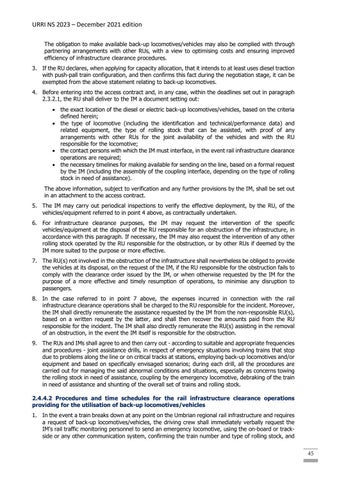URRI NS 2023 – December 2021 edition The obligation to make available back-up locomotives/vehicles may also be complied with through partnering arrangements with other RUs, with a view to optimising costs and ensuring improved efficiency of infrastructure clearance procedures. 3. If the RU declares, when applying for capacity allocation, that it intends to at least uses diesel traction with push-pall train configuration, and then confirms this fact during the negotiation stage, it can be exempted from the above statement relating to back-up locomotives. 4. Before entering into the access contract and, in any case, within the deadlines set out in paragraph 2.3.2.1, the RU shall deliver to the IM a document setting out: the exact location of the diesel or electric back-up locomotives/vehicles, based on the criteria defined herein; the type of locomotive (including the identification and technical/performance data) and related equipment, the type of rolling stock that can be assisted, with proof of any arrangements with other RUs for the joint availability of the vehicles and with the RU responsible for the locomotive; the contact persons with which the IM must interface, in the event rail infrastructure clearance operations are required; the necessary timelines for making available for sending on the line, based on a formal request by the IM (including the assembly of the coupling interface, depending on the type of rolling stock in need of assistance). The above information, subject to verification and any further provisions by the IM, shall be set out in an attachment to the access contract. 5. The IM may carry out periodical inspections to verify the effective deployment, by the RU, of the vehicles/equipment referred to in point 4 above, as contractually undertaken. 6. For infrastructure clearance purposes, the IM may request the intervention of the specific vehicles/equipment at the disposal of the RU responsible for an obstruction of the infrastructure, in accordance with this paragraph. If necessary, the IM may also request the intervention of any other rolling stock operated by the RU responsible for the obstruction, or by other RUs if deemed by the IM more suited to the purpose or more effective. 7. The RU(s) not involved in the obstruction of the infrastructure shall nevertheless be obliged to provide the vehicles at its disposal, on the request of the IM, if the RU responsible for the obstruction fails to comply with the clearance order issued by the IM, or when otherwise requested by the IM for the purpose of a more effective and timely resumption of operations, to minimise any disruption to passengers. 8. In the case referred to in point 7 above, the expenses incurred in connection with the rail infrastructure clearance operations shall be charged to the RU responsible for the incident. Moreover, the IM shall directly remunerate the assistance requested by the IM from the non-responsible RU(s), based on a written request by the latter, and shall then recover the amounts paid from the RU responsible for the incident. The IM shall also directly remunerate the RU(s) assisting in the removal of an obstruction, in the event the IM itself is responsible for the obstruction. 9. The RUs and IMs shall agree to and then carry out - according to suitable and appropriate frequencies and procedures - joint assistance drills, in respect of emergency situations involving trains that stop due to problems along the line or on critical tracks at stations, employing back-up locomotives and/or equipment and based on specifically envisaged scenarios; during each drill, all the procedures are carried out for managing the said abnormal conditions and situations, especially as concerns towing the rolling stock in need of assistance, coupling by the emergency locomotive, debraking of the train in need of assistance and shunting of the overall set of trains and rolling stock. 2.4.4.2 Procedures and time schedules for the rail infrastructure clearance operations providing for the utilisation of back-up locomotives/vehicles 1. In the event a train breaks down at any point on the Umbrian regional rail infrastructure and requires a request of back-up locomotives/vehicles, the driving crew shall immediately verbally request the IM’s rail traffic monitoring personnel to send an emergency locomotive, using the on-board or trackside or any other communication system, confirming the train number and type of rolling stock, and
45

